Thanks to Road Scholar for providing this lifelong learning adventure through Prince Edward Island, Nova Scotia and New Brunswick! As always, all opinions are our own.
Where we’re exploring:
 The Maritimes is a region rich in history — involving sailors and fishermen, pirates and generals, battles and treaties, shipwrecks and rum running, and the birth pangs of two great nations.
The Maritimes is a region rich in history — involving sailors and fishermen, pirates and generals, battles and treaties, shipwrecks and rum running, and the birth pangs of two great nations.
Our journey sets out where Canada began, on Prince Edward Island…
Day One: Red Cliffs and Readiness

We could hardly wait for our Road Scholar program to start so we’re kicking off our day with a stop at the red cliffs at Cavendish. We have just finished re-reading Anne of Green Gables and couldn’t wait another second to visit these cliffs that Lucy Maud Montgomery wrote of. This soft sandstone shoreline is ever changing, as it erodes away at a rate of three feet per year. Beauty in motion.
You always take me to the nicest places!

Stanley Bridge, Prince Edward Island

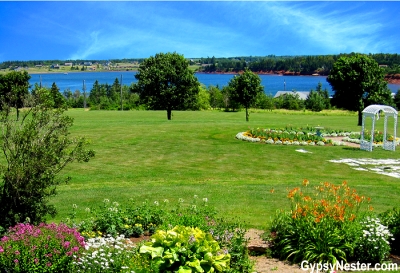
We can’t believe how incredible the weather is – and it’s supposed to hold all week!
We’re all checked in to our room at Stanley Bridge Country Resort – our home base for the next few days. Headed out to explore a bit on foot before meeting our fellow Road Scholar participants after dinner. Excited!
Day Two: Shipwrecks, storms and a little girl named Anne
Morning:
Our morning starts with Boyde Beck, Curator of History for the Prince Edward Island Museum and Heritage Foundation, for an informative and (very) funny presentation about the history, culture and colorful characters of the Maritimes.


Stay tuned for an action packed day – we will be visiting Green Gables National Historic Site to learn the facts behind the fiction of Anne of Green Gables, heading to French River (the most photographed spot on PEI) and exploring the Yankee Gale and the organic farming movement. This evening we will be
attending a community ceilidh.
Afternoon:
GypsyNesters of Green Gables

Green Gables, the house that inspired the novels

So happy: Fellow Road Scholar participants Nancy and Debby have dreamed of Green Gables since childhood!
Click here to see more about Green Gables National Historic Site

Authentic furnishings from the late 1800s were used to lovingly recreate rooms as they were described in Anne of Green Gables.
In 1937, Parks Canada preserved Green Gables by adding it to the National Parks system.

Dave and Conni take a stroll along Anne’s “Lover’s Lane”
Click here to see more about Green Gables National Historic Site
The Yankee Gale

French River has been a quaint fishing village along New London Bay on the north shore for over 300 years. Known for tranquility, it was anything but when the fiercest storm in Prince Edward Island‘s history blew in the night of October 3, 1851. The storm became known as The Yankee Gale because a huge contingent of fishing vessels up from New England was working off shore. When calm returned after two days of blowing, some one hundred ships had gone down and hundreds of sailors perished.

New London Bay Lighthouse
See more about beautiful, red-cliffed Prince Edward Island
What’s Growing On?

Agriculture is the island’s biggest business, with potatoes being the leading crop. In fact, one third of all of Canada’s potatoes are grown on this small island. We pass fields of the spuds, plus barley, beans, hay, and oats on our way to meet Raymond Loo at his Springwillow Farm.

Springwillow stands out from the surrounding farms as an organic operation. Crops are naturally fertilized, and plots rotated between crops and use as pasture… even pig pens.
Veronica was very enamored, but luckily just as she was thinking “Wilbur,” Raymond announced “we don’t name them.”

David has never had the opportunity, much less the desire, to milk a cow… well he finally got the chance in the barn at Green Gables National Historic Site.
Evening:

We stop in for a Céilidh (pronounced Key-lee) in the town of Kensington, where the Long River Players keep the musical traditions of Scotland and Ireland alive. Céilidhs serve up community entertainment and, in the past, facilitated courtship for the young folks. One of our guides, Pete Blanding, leads the players on guitar and vocals as fiddle, banjo, whistle, and the traditional hand drum a bodhrán, round out the group.
See more about beautiful, red-cliffed Prince Edward Island
Day Three: Fox Fur, a French Fort and Frozen Cow Chips
Morning:
We begin Day Three in Summerside, the second largest city on the island with a visit to our guide George Dalton’s family home. We look over the furnishings and heirlooms while he gives us a brief history centered on the work of surveyor Samuel Holland.

Holland was sent by King George in 1764, after England had defeated the French in North America, to survey the newly aquired British holdings beginning with Prince Edward Island. He divided the island into 67 lots of 20,000 acres each, then the lots were distributed to nobility and aristocracy as farms in order to populate the island.

Recently his two hundred fifty year-old maps were compared with satellite photos and proved to be remarkably acurate. His original lines overlay perfectly with many of the current roads, and since he had no interest in drawing these borders with any desire to get from one part of the island to another, the roads based on Holland’s work make for some interesting driving routes.

Veronica attempts to model a fox stole, but is quite
creeped out because the head is still on it!
We also learned about the turn of the century fox business that played a huge part in Summerside history. When Charles Dalton and Robert Oulton came up with a viable way to breed silver foxes in captivity, the boom was on.
Fortunes were made as pelts and breeding pairs were sold for higher and higher prices, until war provided the pin to pop the bubble.

A fox house in Summerside
The prosperity gave rise to the term “fox house.” This does not refer to a place where little furry fellahs live, but the mansions that their owners built with the new found wealth.
Afternoon:

We make a quick stop in Victoria-by-the-sea and take a walk out on the dock, just in time to watch a crab fisherman unload his catch for the day.
See more about beautiful, red-cliffed Prince Edward Island

Then off to Port-la-Joye, former capital of the island when it was under French control and called Île Saint-Jean.

Red cliffed Port-la-Joye Fort Amherst (Charlottetown is seen in the distance)
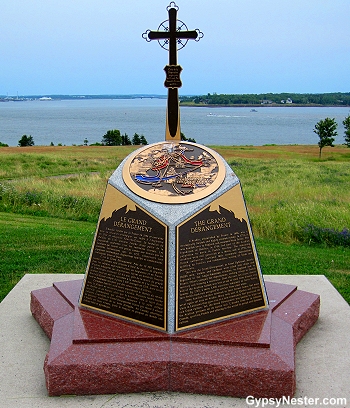
The Acadian Monument at Port-la-Joye
Once again Boyde Beck brings history to life with his description of how Port-la-Joye was captured in 1745 by New Englanders from the colonies to the south, who built a new fortification called Fort Amherst. British rule ultimately led to renaming the island in honor of Prince Edward.
Fourteen years later this was the site of a second Expulsion of the Acadians, the French settlers in the Maritimes, when three thousand were sent away during The Seven Years’ War. Perhaps even more tragic than the first, only half about half made it to France due to shipwrecks and disease.
See more about the Acadian, Canadian and Cajun (Louisiana) connection
Evening:
The Cradle of Canada

Just across the harbor, in Charlottetown, we find some slightly more recent history in the very room in Province House that hosted the Charlottetown Conference. This housed the first meeting in the process leading to the creation of Canada in 1867, the cradle of the confederation so to speak.
The provincial legislature still convene in a room at the other end of the second story hall.
See more about beautiful, red-cliffed Prince Edward Island
Having a cow!

Chip Chip Hooray! Fellow Road Scholar participant, Martha
Charlottetown is also home of arguably the world’s best ice cream at Cows Creamery. By using only premium ingredients, upping the butter fat content to 16%, and reducing the air content to nearly zero, they have created the richest dairy dessert we’ve ever had the pleasure of licking off a cone.

Ignoring the calories and just goin’ with it. Mmmmm.
The names for the flavors are an absolute hoot, like Wowie Cowie, Moo York Cheesecake, and Messie Bessie. We indulge in Gooey Mooey, with burnt sugar ice cream, English toffee, caramel cups, and chocolate flakes; along with Chip Chip Hooray, featuring their “cow chips” – P.E.I. potato chips dipped in chocolate.
Day Four: Lobster, A Really Long Bridge and New Brunswick
Morning:

Loretta Jollimore, the “L” of L & C Fisheries since it began in 1978, gives us the low down on lobsters.
How to catch them, band their claws, measure them, tell the sex, store them, ship them, and most importantly… cook and eat them.
WATCH: Loretta shows us how a lobster trap works and explains the difference between the boys and the girls!
L & C also farms mussels, grown on lines out in the bays, and ships them on ice all over the world under the brand name Green Gables Mussels. Cultured mussels is a rapidly growing business on Prince Edward Island with about forty million pounds produced each year.
See more about beautiful, red-cliffed Prince Edward Island
Afternoon:
To make our way to New Brunswick, we cross eight miles over the Northumberland Strait on The Confederation Bridge.

Our first stop in New Brunswick is Fort Beauséjour, built by the French to protect the route to Quebec. It was still unfinished in 1755 when the British attacked and captured it in what was a key battle in Father Le Loutre’s War.

The defeat ultimately led to France losing control of Acadia, and finally all of its colonies in North America except the tiny islands of St. Pierre and Miquelon just off the coast of Newfoundland. After the victory the fort was renamed Fort Cumberland and was the site of the proclamation that led to the deportation of thousands of Acadians.
See more about the Acadian, Canadian and Cajun (Louisiana) connection

Nearby, we make a stop on the shore of the Bay of Fundy, renowned for the highest tides in the world. During just a few minutes while listening to our guide, Al Smith, explaining the phenomenon the water rises several feet on its way to a high tide of about forty-five feet.

The shape of the bay, like a funnel and, its length out to the open Atlantic, combine to cause the giant tidal fluctuations.
See more about beautiful New Brunswick
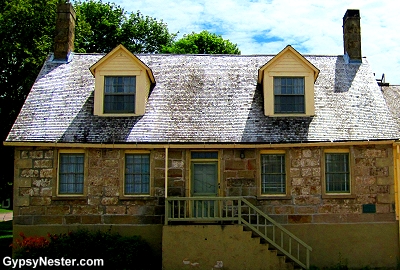
We stop for lunch just off the bay at The Bell Inn in the town of Dorchester. The inn is housed in New Brunswick‘s oldest stone building, and served something that tied in nicely with this morning’s activity at the fishery, lobster rolls.



The Wheaton Covered Bridge is the last left of the covered bridges in the Tantramar Marshes and traditionally lovers have been kissing under it since the horse and buggy days. We caught fellow Road Scholar participants Dottie and Jerry living up to the custom.
The area takes its name from the Acadian French word tintamarre, meaning din or racket, in reference to the noisy flocks of birds living in the swamp land that is now a National Wildlife Area and bird sanctuary.
The Acadians built earthen dykes throughout this region to reclaim the salt water marshes from the sea. Once the new land was blocked off from the tide and exposed to fresh water it became fertile farmland.

See more about the Acadian, Canadian and Cajun (Louisiana) connection
Evening:
In the town of Sackville, known as Pré des Bourgs to the Acadians, we pass by the last octagonal house in New Brunswick. The home, in the once popular style, was built in 1855 by Captain George Anderson.

Sackville is also home to the Campbell Carriage Factory, which is now a museum.
A walk through gives us a start-to-finish look at the construction of horse drawn carriages and sleighs.
See more about Campbell Carriage Factory Museum
Day Five: Blueberries, The Great Upheaval and Nova Scotia
Morning:
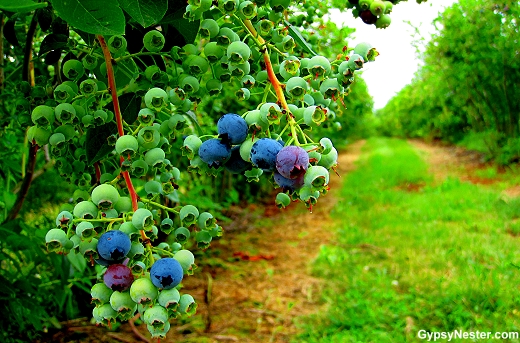
Leaving New Brunswick we make our way into Nova Scotia, Latin for New Scotland, and the Annapolis Valley. At Blueberry Acres we are in the middle of two hundred acres of high bush blueberries, and get an introduction to the business of growing berries, from planting, to picking, to packing.

Meanwhile — randomly — a canon goes off in the never ending effort to keep birds from eating all the profits. Our guide describes the various ways this is done – the canons, piping in predatory bird sounds (a walk through the bushes sounds like a jungle excursion!) and statues of swooping “eagles” in strategic locations.

Between the Bushes Restaurant is also a part of the complex, situated smack in the middle of the farm, and blueberries are incorporated into many dishes.
We start off with pure, sweet blueberry juice, then move on to their signature blueberry barbeque chicken. Somehow, even with a blueberry dessert, we felt not an inkling of overload.
Afternoon:
Evangeline and the Acadians

See more of Grand-Pré National Historic Site

Honored: We shared a special moment with fellow
Road Scholar participant, Dottie, as she found her Acadian ancestors
The town of Grand-Pré was first settled around 1680 by Pierre Melanson dit La Verdure, from the nearby first capital of Acadia, Port-Royal.
As the settlers built dykes to hold back the tides along the Minas Basin it outgrew Port Royal and became the bread basket of Acadia.
It was also the site of one of the biggest deportations of Acadians, when in 1755 the city was burned and the inhabitants sent away during what became known as The Great Upheaval.

In 1847 Grand-Pré was immortalized in the epic poem, Evangeline, by Henry Wadsworth Longfellow as the home of the tragic heroine by the same name.
See more about the Acadian, Canadian and Cajun (Louisiana) connection
Evening:

Our final stop of the day is Gaspereau Vineyards, the first of several wineries that have sprung up in the Annapolis Valley since 1996. They’ve planted thirty-five acres up the side of a south-facing hill that provides the sun and drainage ideal for growing grapes.

The white wines are the stars at Gaspereau, especially L’Acadie Blanc, named in honor of the local Acadian culture, and Tidal Bay, in a nod to the nearby Bay of Fundy. Both are crisp, light, and refreshing. Another unique, and very Canadian, ingredient is used in their port — maple syrup. Makes for a tasty after dinner drink… or it could be poured over pancakes. 😉
Day Six: Halifax. Titanic Tales and an Epic Explosion
Morning:

Fellow Road Scholar participant, Barbara, poses with
a very handsome (and very serious) Highlander
Overlooking downtown and the harbor, our first stop is Fort George, named for King George II, on the summit of Citadel Hill. What we see is a reconstructed version of the forth incarnation of the fortress that has been on this spot since 1749. No longer a military installation, it is a part of Parks Canada and guarded by re-enactors of the famous 78th Highlanders Regiment.

We continue with a stroll through the Public Gardens. This is truly a Victorian garden since it dates back to 1867, during Queen Victoria’s reign.
Flowers and plants from many varied climates line the walkways, with everything from cactus, to yucca, to roses, to towering trees represented. The roses smell so sweet, it’s like walking through a cake!
See more of Halifax’s Public Gardens
On a more somber note, we stop by the Fairview Lawn Cemetery to pay our respects at the graves of over one hundred of the casualties of the Titanic. Many of the headstones are marked with only numbers, as the identities of the victims remain unknown.
Click here to see our full story on Halifax
Perhaps the most poignant is an unknown grave of a two-year-old child brought back aboard the MacKay-Bennett, one of three ships sent out from Halifax to retrieve the deceased from the site of the disaster.
Just recently the boy was identified through DNA samples, but his family prefers that he continue to be a remembrance for all of the other unknown victims.
See more information and photos of the Fairview Lawn Cemetery
Afternoon:

At Pier 21, sometimes called Canada’s Ellis Island, we learn about how over one million immigrants entered the country. Many were fleeing wars or oppression, others seeking economic opportunity, and still another group reuniting with spouses met during World War II. These were known as war brides, and nearly 50,000 arrived here to enter their new home.

We spend the remainder of the afternoon in the Maritime Museum of the Atlantic investigating the rich seafaring history of Nova Scotia.
The collection includes a nine foot high lens from the Sambro Island Lighthouse, the oldest surviving lighthouse in North America.
Click here to see our full story on Halifax

Shipwrecks are a big part of Halifax history, and the museum chronicles hundreds of them. Salvaged artifacts from dozens are on display, including a few from perhaps the most famous ever, the Titanic.
Once again we are reminded of the unknown child victim of the disaster when we come upon his little shoes in one of the cases.

A deck chair from the Titanic
See more Maritime Museum of the Atlantic
Another disaster struck the city just a few years after the sinking of the Titanic, the Halifax Explosion. On December 6, 1917 the SS Mont-Blanc, a French cargo ship filled with wartime explosives, collided with the Norwegian vessel SS Imo in the harbor. The Mont-Blanc caught fire and the resulting blast was the largest ever until the atom bomb.

At least two thousand people perished, with thousands more injured and left homeless. Aid poured in from all around, but Boston stood out in the relief effort, sending many ship loads of supplies. To this day, the city of Halifax sends a Christmas tree to Boston every year as a continuing thank you gift.
Read about Vincent Coleman, an amazing hero of the Halifax Explosion
Click here to see our full story on Halifax
Evening:

On the pier we have some free time for a bite, and we set out alone, GypsyNester style, to find some quintessentially Canadian street food. Good old poutine, french fries with gravy and cheese curds, which typically doesn’t include bacon (but bacon is always good!) and is more common inland around Quebec and Ontario; and a new item for us, donair, which is like a pita wrap of gyro meat served with a sweetened condensed milk sauce, and is unique to the Halifax area.
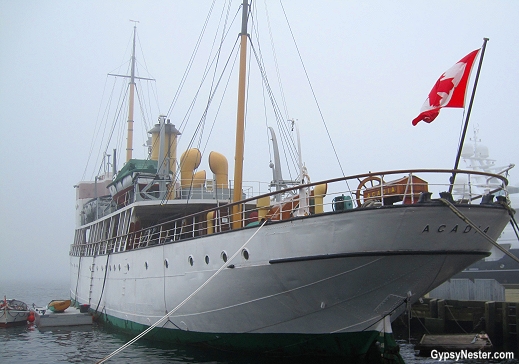

We sit and eat in the shadow of the tall ship Acadia. As always, poutine may not sound great, but no matter who we are with or where we try it, we never seem to see any leftover in the basket.
As for donair, the blend of spicy meat and sweet sauce works, but the sweet could be dialed back a notch or two without any complaints from us.
Click here to see our full story on Halifax
Day Seven: Scottish Settlement, Crossing the Strait and Fond Farewells in Lobster Bibs
Morning:

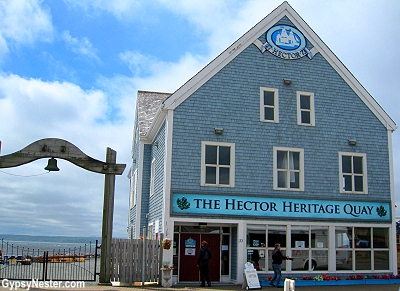
At Pictou we stop to see the Hector, famous for being the ship that brought the first Scottish settlers to Nova Scotia in 1773. A perfect replica of the ship, made from the original blueprints, highlights the museum. The exhibit chronicles the Scots fleeing the Highland Clearances in Scotland and making the arduous journey across the Atlantic to start new lives in Nova Scotia.
See more about the Hector and Pictou

Aboard The Hector, we get a small sample of just how crowded two hundred people would be on a one hundred foot ship. In the holds there was only room for one bunk per family, so everyone had to take turns sleeping. Because of a horrific storm, the trip that should have lasted six or seven weeks ended up taking eleven, and eighteen passengers died out at sea.

Scores of tartans line the walls of the museum, representing the clans of the families aboard. Veronica’s maiden name is Stewart… perhaps a relative?
See more about the Hector and Pictou
Afternoon:


Fellow Road Scholar participants, Nancy & Floyd,
find the romance of the sea
Straight from that harrowing story to a crossing of our own, without any of the hardships of course, the The MV Confederation ferries us across the Northumberland Strait back to Prince Edward Island.
To make the trip especially enjoyable, we are treated to live, local music as we watch the red cliffs dreamily come back into view.

See more about beautiful, red-cliffed Prince Edward Island
Evening:

We finish our amazing adventure through Canada’s Maritime Provinces with a traditional island lobster supper. Since we are back on Prince Edward Island, potatoes are also an important part of the meal. Over our delicious dinner we look back over our phenomenal experiences of the preceding week, rehash, recount and, after lingering as long as we could over dessert, bid fond farewells to all of the amazing new friends we have bonded with along the way.
Bon voyage to wherever the travel bug takes us all next!
David & Veronica, GypsyNester.com
YOUR TURN: Have we inspired you to embark on a Maritimes adventure? What would be your first stop?
Thanks to Road Scholar for providing this lifelong learning adventure through Prince Edward Island, Nova Scotia and New Brunswick! As always, all opinions are our own.



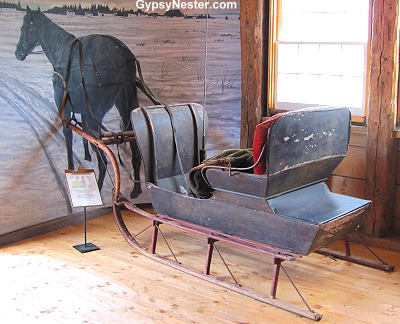





Happy to hear you enjoyed your time in our little part of the world. The Martimes has so much to share. So sad you did not take time to visit Cape Breton. The area is so rich in history and has such breath taking beauty it should never be missed.
We did get to drive around Cape Breton on our way up to Newfoundland, and you’re right, it is gorgeous. Didn’t get to see nearly as much of it as we would like.
Sounds like you had an amazing experience in our fair part of the world! Too bad you had not taken the time to relax and make your way around Cape Breton, NS. A place so steeped in history with some of the most
breath taking beauty is part part of the Maritimes not to be missed.
I realize myself to be quite late in this conversation, but would like very much to thank you for this lovely blog! It will be fun to show this to my Mother-In-Love, to show her the fun of blogging her trip to Scotland this month coming up!
She wants very much to have something just like this, I think.
Again, many thanks!
Thanks to you too! Hope your mother has a great time.
Calli’s dad is building a cottage on the ocean in PEI, and we cannot wait to use that as a home base to explore Eastern Canada and the Maritimes.
Sounds like a great setup.
David and Veronica….thanks so much for the great coverage of our Northshore Institute Road Scholar program. Thanks for being a great part of the group, for your wonderful photos and your informative write-ups. Happy Travels!
We had a great time, as always Road Scholar has wonderful people showing the way. Thanks!
LOL the cow-milking picture takes the cake. Looks like you had a great time!
Great post, folks! Looks like you had a blast! Then again, we’d expect nothing less 🙂 Thanks for sharing!
Your photographs are wonderful! They make me want to be back in my home country: Canada!
Thank you, glad to give you a taste of home.
Fun post – the milking photo cracks me up and that water looks sooo refreshing.
Definitely a good time for all.
Lovely! Please eat at our fave place. The preserve company! Sooooo good.
Mike
Thanks, where is it?
Is that a real cow, like the real moose in the Metro South Convention Centre in Toronto? I mean it looks kind of glassy eyed, but I don’t want to jump to conclusions because maybe Canadian cows are more, um, composed than American cows. Seems like a great trip. I’ll be following along.
It is every bit as real as that moose. Real meaning it exists and can be touched. Living and breathing… not so much.
Just ended a three-month road trip through the Eastern Canadian provinces, including the Gaspe and a month on Newfoundland. You have quite an adventure ahead.
Try to see the Cabot Trail around Cape Breton Island and maybe make it to Newfoundland if you can. (At least the Viking Trail with its 2 UNESCO sites.)
I’ll look forward to revisiting the area with you.
We did Newfoundland just before this trip and it was fantastic!
Thanks, we are too!
Welcome to my part of the world! I’m so glad you’re going to get to see some of it!